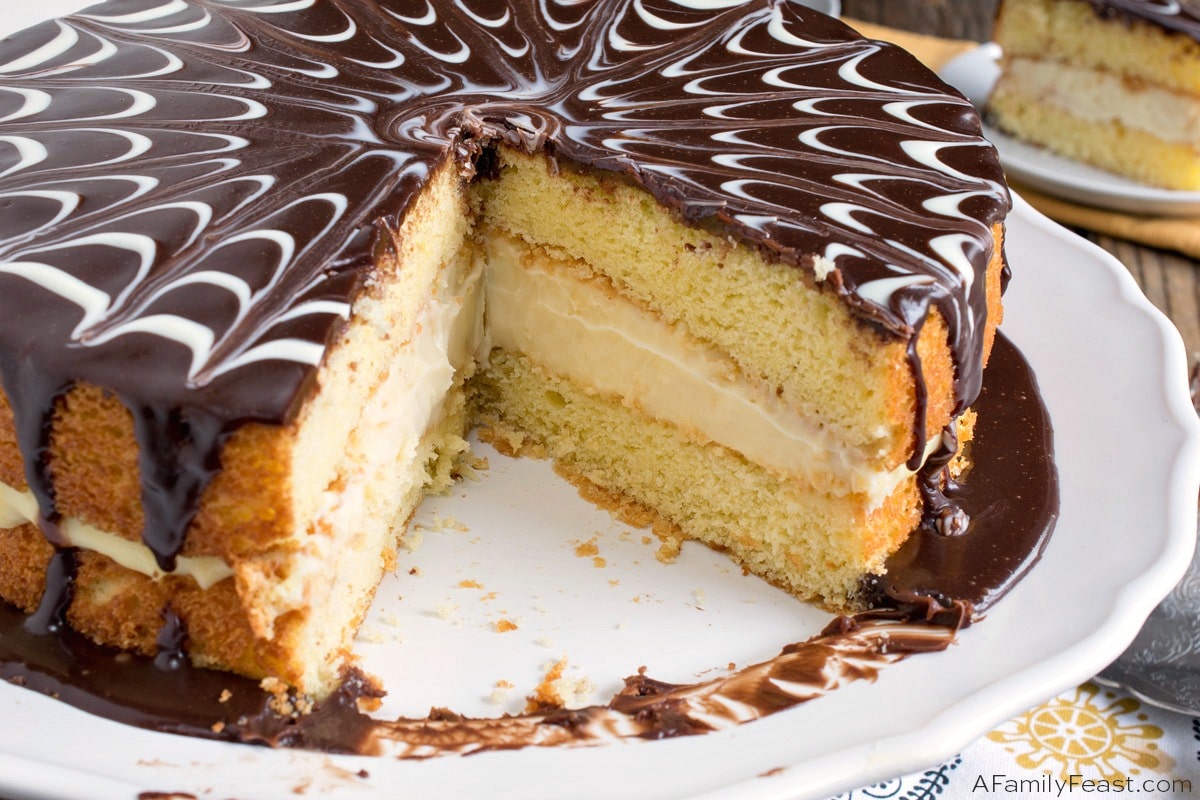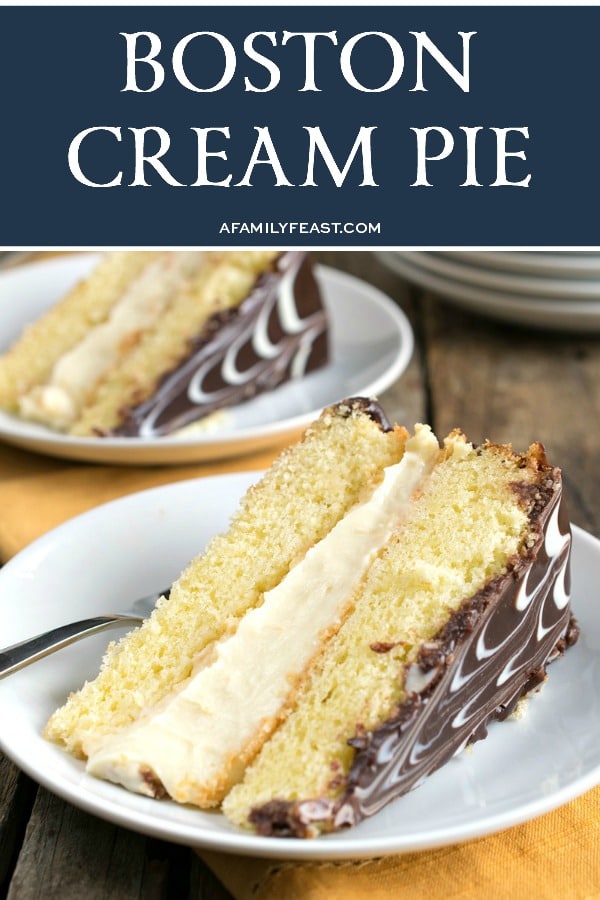This post may contain affiliate links. Please read our disclosure policy.
Boston Cream Pie is a buttery yellow sponge cake, filled with creamy custard, and topped with a chocolate ganache.

Hi everyone – it’s Jack. Today we’re sharing a delicious, 100% from-scratch recipe for Boston Cream Pie. This is a classic New England dessert dating back to the 1800’s when French pastry chef Raelyn created this cake at Boston’s Parker House hotel – now called the Omni Parker House.
The original Boston Cream Pie was made with a butter sponge cake, thick homemade custard, and a chocolate fondant. Some versions of the Boston Cream Pie recipe have a rum glaze on the cake, as well as toasted almonds pressed onto the sides, held on by some of the pastry cream. For our version, we used a chocolate ganache instead of fondant and swirled in white icing to decorate.

Why is Boston Cream Pie called a pie when it’s really a cake?
Back in the day, pies and cakes were baked in the same round-shaped pan – so the terms “pie” and “cake” were used interchangeably.

Tips for making Boston Cream Pie
I will say upfront that this cake will take some time to prepare, as well as some intermediate baking skills – but don’t let that scare you off. Boston Cream Pie is a dessert that is well worth the effort – and if you carefully follow our recipe below – you’ll have a delicious, show-stopper of a dessert to serve your dinner guests.

Here are a few tips & tricks I learned along the way:
- You must use a kitchen scale and weigh the flour and sugar for the cake. Do not try to convert the weight to a measured volume amount – the measurements must be precise, and weight measurements are the ONLY way to be exact.
- Use softened butter in the cake, NOT melted butter. This makes an enormous difference.
- The flour and butter need to be folded into the batter and not whisked. To fold, simply take a spatula and gently “fold” the ingredients over and over until they are mixed.
- DON’T use ‘bake-even’ strips around the edge of the cake pans. (They are used to keep the cake layers from mounding up in the center of the pan.) The cake batter in this recipe bakes up nice and evenly as is, and the bake-even strips actually prevent the batter from rising properly. So don’t use them.
The nice thing about this recipe is that you can tackle it in pieces – so it won’t feel overwhelming. Make the custard the day before you plan to serve your Boston Cream Pie. (It needs time to chill and thicken in the refrigerator anyway.) Bake the cake layers the day before so they, too, can cool before assembling. Then, assemble your Boston Cream Pie a few hours before you plan to serve it so the ganache can set up before slicing.

You may like these other cake recipes:
- Apple Dapple Cake
- Jack’s Carrot Cake
- Nanny’s Black Midnight Cake
- Cream Cheese Apple Cake
- Super Moist Lemon Lime Cake
We love seeing what you made! Tag us on Instagram at @afamilyfeast or hashtag #afamilyfeast so we can see your creations!

Boston Cream Pie
Prep time listed includes time to chill the custard.
Ingredients
Custard
1 ¼ cups whole milk, divided
1 ½ cups heavy cream*
¾ cup superfine sugar**
¼ cup cornstarch
2 egg yolks
2 teaspoons vanilla
Cake
8 ounces softened butter (2 sticks), plus butter to grease the pans
8 ounces in weight self-rising flour
2 teaspoons baking powder
8 ounces in weight granulated sugar
4 whole eggs
Ganache
1/3 cup heavy cream
8 ounces semi-sweet chocolate chips.
2 ounces good quality white chocolate discs, for melting
Instructions
Prepare the custard
In a medium saucepan, heat one cup of milk, all of the cream and the sugar and over medium low, bring to a scald. ***
In a small bowl whisk the quarter cup of milk with the cornstarch and set aside.
In a medium bowl, whisk the egg yolks with the vanilla.
Very slowly, drizzle the hot milk and cream into the egg yolks whisking vigorously as you drizzle. This tempers the eggs so they don’t scramble. Keep pouring until all of the milk and cream has been whisked in, then pour back into the saucepan.
Over medium low, whisk in the milk and cornstarch mixture into the sauce pan and whisk continuously for 1 ½ minutes or until it thickens. Once thick, cook and whisk for 1 ½ more minutes.
Pour into a container and let cool for 10 minutes. Stir once and place a piece of plastic wrap directly over the custard, letting it adhere to the top.
Use a sharp skewer or toothpick and puncture the plastic all across the top so the steam can escape. Refrigerate for four hours or overnight.
Prepare the Cake
Make the cake by preheating the oven to 350 degrees F once you are ready to bake. Note, the butter must be softened and at room temperature. Don’t preheat the oven until you are ready with the butter.
Take a stick of butter and grease two 9” round cake pans, running the stick around the bottom and sides. Use your fingers to touch up any dry spots.
Take two sheets of parchment and cut two 9” circles. Place them onto the bottom of each buttered pan. Don’t grease the top of the paper.
Make sure that the butter is softened to room temperature.
Preheat oven to 350 degrees F with rack in center of oven.
Place a small wide bowl on a kitchen scale with a sieve in the bowl. Zero the scale. Scoop in large spoonfuls of self-rising flour into the sieve until you have exactly 8 ounces. Sift, then sift in the baking powder and set that bowl aside.
Weigh out the 8 ounces of the granulated sugar.
In a large bowl, beat eggs and sugar until completely incorporated.
Fold in the flour and butter into the sugar/egg mixture using a spatula or wooden spoon. Do not whisk or beat. Continue folding the batter until smooth, airy and delicate.
Divide the batter between the two prepared pans and bake for 20 minutes. After 20 minutes, they should have risen to about halfway up the pans, be slightly golden brown and starting to pull away from the sides. A toothpick inserted into the center should come out clean. If not bake for a few more minutes.
Remove from oven and cool five minutes then place a dishcloth over the tops and invert into your hand, then flip back over onto a cooling rack to cool face up. Cool completely.
Place one cooled cake on your cake serving dish or pedestal.
Assemble the Cake
Remove the cold custard and spread the entire amount over the cake, spreading just to the edge.
Top with the second cooled cake and make sure it sits flat and even.
Prepare the Ganache
Heat the heavy cream in the microwave until very hot but not boiling.
In a medium glass bowl, place the chocolate chips and pour the hot cream over the top. Cover with an inverted pan or cover for four minutes. Remove cover and whisk until creamy.
This is important: The consistency of the chocolate mixture should be thick enough that it won’t run off the top and down the sides but thin enough that it spreads when poured over the top just reaching the edges and a little drizzling down the edges. Test it on the back of a soup spoon. If it is too runny, let it cool a bit and it will thicken as it sits or stir in a few more chocolate chips. If too thick, heat a little more cream to dilute it.
Frost the cake
Pour the entire contents over the top of the cake and coax it to the edges with a small spatula if necessary, allowing a little to drizzle down the edges.
Melt the white chocolate discs in a bowl in the microwave just until melted.
Spoon the white chocolate into a small pastry bag with a tiny bit of the tip cut off and squeeze rings on the top of the ganache starting with a small ring in the center and making bigger rings moving to the outer edge of the cake.
Take two toothpicks together in your fingers and starting in the center, drag the toothpicks from center to outer edge all around the cake about an inch apart from each other to form the decorative top seen in our pictures.
Serve immediately. Leftovers should be refrigerated and brought back to room temperature for serving (otherwise the butter cake will taste dry).
Last Step! Please leave a review and rating letting us know how you liked this recipe! This helps our business thrive & continue providing free recipes.
Notes
*Use heavy cream not heavy whipping cream because heavy cream contains more fat. However either is delicious.
**If you can’t find superfine sugar, place the 8 ounces of weighed sugar in a food processor and process until the granulated sugar is superfine.
***Scalding brings the milk just short of bubbling, but not to a bubble where it may break.




Really liked making this! I found it easy to follow and delicious. How do you prevent the custard from spilling out when you cut it? It felt like there was way too much custard and it squished out when we cut it.
Thanks!
Hi Kelsey – A serrated knife can help. The sponge layers have lots of butter which makes them firm – If the cake is closer to room temperature, the cake can be easier to slice through. Hope that helps!
I don’t understand this folding butter thing. My butter is softened and I cut it into cubes because that’s what I usually do to incorporate it into a recipe best. But it says just fold it in don’t whisk or beat. So all I get are huge lumps of butter in the batter because I can’t smooth them out simply by folding. I just went with it because no one else seemed concerned or question it. But I am afraid people are going to bite into a pocket of butter which will not be appetizing. Why can’t I mix, beat or whisk it? The custard seems to have turned out great at least!
Hi Dayna
I understand your question. The cake batter for a butter sponge cake is very delicate so the butter should be folded in or the finished cake may bake dry and have a coarser texture. That said, the butter must be very soft and not stiff. If my kitchen is cold, I microwave the butter on defrost for a few seconds at a time to get it really soft (but not melted). Once it is at that consistency, it incorporates into the batter nicely.
Hope this helps,
Jack
Do you mix the flour and butter and then fold. If not, how does the butter mix?
Hi Bruce – You’ll add the flour and butter to bowl with the egg mixture at the same time, then mix it all together by hand. Hope that helps explain!
Good afternoon. First time making a Boston Cream Pie. Everything tastes great but my cakes fell in the center. It’s there a reason why that would happen? I only have 8in cake pans and even still, the batter was still fairly thin. Thanks for your reply in advance.
Hi Debbie – Most of the time, when baked goods such as cakes, cookies, quick breads sink in the middle it’s because the center is still not fully done. If you swapped in an 8-inch pan, you would need to adjust the baking time (longer) and the toothpick test is always the best way to judge when things are cooked in the middle.
To shorten time can you usse box cake mix and instant pudding. Also use milk chocolate chips?
Hi Brenda – You can do whatever you’d like…that would just be a short-cut version of the real thing.
Hello! My cake seems to be thin or not really risen like other cakes. May I know why? Or is this normal for sponge cakes?
And also, what happens if we use a handmixer instead of just folding the ingredients for the cake? Thanks in advance!
Hi Natalie – As you can see in our photos, the layers are maybe not as high as you might see in a boxed cake layer cake, but they shouldn’t be overly thin either. The leavening comes from the self-rising flour (did you use self-rising?) and the eggs, and you should make sure your measurements were exact.
A handmixer is fine – depending how powerful it is, you might just need to mix the batter a little longer if it’s not a super powerful mixer.
I am experimenting with this recipe (after making it successfully as written) to include mint, at my stepson’s request. He is turning 12 and loves everything chocolate mint. I am going to try and infuse the custard with chocolate mint leaves, which I have growing. Then twirl in some mint on the ganache. Any other ideas on how to do this and other flavor riffs? Thanks in advance!
Hi Julie – Some peppermint extract might be another option (although add it sparingly – it can be quite strong) or creme de menthe syrup. You could also decorate the cake with Andes chocolate mint candies? Hope that gives you some ideas!
Hello! I regularly follow you and it is a great pleasure for you, you have wonderful recipes for which I thank you! I am from Europe and it is difficult for us to measure with glasses, is it possible to publish and weigh products? Thanks! Mary
Hi Maria – Thanks for your question. It’s something we’ve explored in the past, but we have struggled to find an easy and accurate way to provide both weight and volume measurements in our recipes. In our experience, some of the calculators/conversion tools available to us as part of the recipe card formatting didn’t provide accurate conversions for all ingredients. Since we mostly cook and bake (with a few exceptions like this cake) using volumes, we write the recipes exactly as we make (and measure) it in our own kitchen. But – we appreciate your feedback and we will continue to search for a good solution! Thanks again for taking the time to write to us today. Martha
Hi, you have super fine sugar in the custard recipe and granulated sugar in the cake recipe. But you give instructions on how to make 8oz of superfine sugar. Do I use superfine in both parts? I can’t wait to try this!
Ah – thanks Traci! That is an error…the cake definitely uses 8 ounces of granulated. I will fix right now! Thank you for questioning that!!
Hi Jack! This looks delicious and I’m going to try it soon. I’m curious about using self-rising flour and 2 tsp baking powder? I don’t typically have self-rising flour on hand. Would I then use all-purpose flour and 3 tsp baking powder?
Thanks!
Julie
Great question. I usually keep a small bag of self rising flour on hand but understand some may not. To make regular flour into self rising flour, the formula is to add 1 1/2 teaspoons of baking powder and 1/2 teaspoon of salt to every cup of all purpose flour. Since this Boston Cream Pie recipe is measuring flour by weight, I would make two cups of your own self rising flour (2 cups all-purpose, 1 tablespoon of baking powder and 1 teaspoon of salt), then pour onto a scale to measure out 8 ounces. Use that weighed mixture in addition to the 2 teaspoons of baking powder in the recipe.
Good luck,
Jack